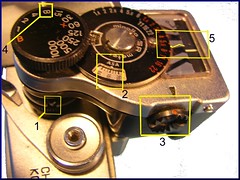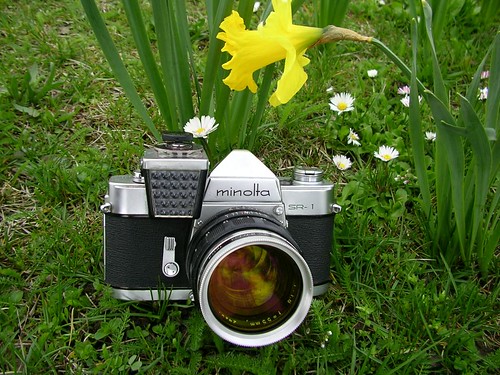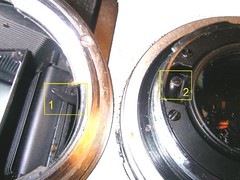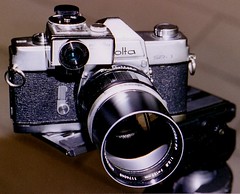Difference between revisions of "Minolta SR-1"
(Fixing the English, mostly. A lot of reorganization is still necessary.) |
(minor adjustments to the English; still a mess) |
||
| Line 1: | Line 1: | ||
<div class="floatright">[http://www.flickr.com/photos/89864432@N00/138576923/in/pool-camerapedia/ http://static.flickr.com/46/138576923_a1f024a35d.jpg]</div> | <div class="floatright">[http://www.flickr.com/photos/89864432@N00/138576923/in/pool-camerapedia/ http://static.flickr.com/46/138576923_a1f024a35d.jpg]</div> | ||
| − | The '''Minolta SR-1''' was the second model of [[Minolta]]'s first series of [[SLR]] camera bodies. It | + | The '''Minolta SR-1''' was the second model of [[Minolta]]'s first series of [[SLR]] camera bodies. It is a purely mechanical camera. A six-element 55mm Rokkor was the standard lens. When it was introduced in 1959 several other Minolta [[Rokkor]] lenses were already available, from 35mm up to 600mm. |
| − | In 1961 a holder ('''1''') for an additional selenium exposure meter was added. The applicable meters for the SR-1 were connected mechanically with the shutter-speed preselector of the camera: The little bolt ('''2''') on the camera's preselector was connected to the clutch ('''3''') of the meter's shutter-speed preselector. When the correct ASA-value of the film and the exposure time were preselected on the meter, the measuring instrument's scale directly showed the aperture that the user had to select at the lens. | + | At least five different improved versions of the SR-1 were brought to the market in the following three years. In 1961 a holder ('''1''') for an additional selenium exposure meter was added. The applicable meters for the SR-1 were connected mechanically with the shutter-speed preselector of the camera: The little bolt ('''2''') on the camera's preselector was connected to the clutch ('''3''') of the meter's shutter-speed preselector. When the correct ASA-value of the film and the exposure time were preselected on the meter, the measuring instrument's scale directly showed the aperture that the user had to select at the lens. |
| − | Another | + | Another accessory for the SR-1 was the flash shoe. |
| − | The SR-1's predecessor was the [[Minolta SR-2]], the first SLR camera for Minolta's SR Rokkor lenses, which was also the first camera to combine several <!-- Which? --> typical features of modern SLR cameras. Later the SR-3 took the place of the SR-2. Both cameras have the 1/1000s as the fastest shutter speed, the SR-1 the 1/500s (only the very last model, the SR-1s of 1967 had 1/1000s). In 1962 the first Minolta SLR camera with built-in meter | + | The SR-1's predecessor was the [[Minolta SR-2]], the first SLR camera for Minolta's SR Rokkor lenses, which was also the first camera to combine several <!-- Which? --> typical features of modern SLR cameras. Later the SR-3 took the place of the SR-2. Both cameras have the 1/1000s as the fastest shutter speed, the SR-1 the 1/500s (only the very last model, the SR-1s of 1967 had 1/1000s). In 1962 the first Minolta SLR camera with built-in meter was introduced as last member of the SR-n-family: the SR-7. One of the SR1 models, the SR-1 (V), was the base on which the [[Minolta_SRT_101|Minolta SR-T 101]] had been developed. |
<div class="floatright"> | <div class="floatright"> | ||
| Line 17: | Line 17: | ||
<div align="center">[http://www.flickr.com/photos/89864432@N00/138576918/in/pool-camerapedia/ http://static.flickr.com/45/138576918_5f313e6fe4_m.jpg]</div> | <div align="center">[http://www.flickr.com/photos/89864432@N00/138576918/in/pool-camerapedia/ http://static.flickr.com/45/138576918_5f313e6fe4_m.jpg]</div> | ||
| − | '''Metering is simple''': The meter | + | '''Metering is simple''': The meter is put into its holder and its shutter-speed selector's clutch connected correctly to the camera's selector's bolt('''1'''). Then the film speed (ASA) is selected on the meter ('''2'''), and the meter mode to be chosen ('''3'''). Shutter speed is chosen for each exposure with the meter's selector ('''4'''). The correct aperture is shown by the meter ('''5'''). Finally the aperture is selected at the lens manually. |
|} | |} | ||
<div align="right">[http://www.flickr.com/photos/89864432@N00/128954560/in/pool-camerapedia/ http://static.flickr.com/53/128954560_b2a36dc955.jpg]</div> | <div align="right">[http://www.flickr.com/photos/89864432@N00/128954560/in/pool-camerapedia/ http://static.flickr.com/53/128954560_b2a36dc955.jpg]</div> | ||
| Line 32: | Line 32: | ||
The SR camera series's lens mount was a sophisticated new sort of lens bayonet. The lens had to be put into the bayonet ring of the camera body. There it had to be fixed by turning it 54 degrees to the right. By fixing it a tappet ('''1''') which belonged to the shutter release mechanics had been | The SR camera series's lens mount was a sophisticated new sort of lens bayonet. The lens had to be put into the bayonet ring of the camera body. There it had to be fixed by turning it 54 degrees to the right. By fixing it a tappet ('''1''') which belonged to the shutter release mechanics had been | ||
| − | connected to the aperture release lever ('''2''') of the lens. <!-- I can't parse the last sentence. What does the tappet belong to, and what's the subject of "had been connected"? (Hoary) --> | + | connected to the aperture release lever ('''2''') of the lens. <!-- I can't parse the last sentence. What does the tappet belong to, and what's the subject of "had been connected"? Matters of English aside, content: What is or was "sophisticated" and/or new? (Hoary) --> |
|} | |} | ||
</div> | </div> | ||
Revision as of 01:06, 6 May 2007
The Minolta SR-1 was the second model of Minolta's first series of SLR camera bodies. It is a purely mechanical camera. A six-element 55mm Rokkor was the standard lens. When it was introduced in 1959 several other Minolta Rokkor lenses were already available, from 35mm up to 600mm.
At least five different improved versions of the SR-1 were brought to the market in the following three years. In 1961 a holder (1) for an additional selenium exposure meter was added. The applicable meters for the SR-1 were connected mechanically with the shutter-speed preselector of the camera: The little bolt (2) on the camera's preselector was connected to the clutch (3) of the meter's shutter-speed preselector. When the correct ASA-value of the film and the exposure time were preselected on the meter, the measuring instrument's scale directly showed the aperture that the user had to select at the lens.
Another accessory for the SR-1 was the flash shoe.
The SR-1's predecessor was the Minolta SR-2, the first SLR camera for Minolta's SR Rokkor lenses, which was also the first camera to combine several typical features of modern SLR cameras. Later the SR-3 took the place of the SR-2. Both cameras have the 1/1000s as the fastest shutter speed, the SR-1 the 1/500s (only the very last model, the SR-1s of 1967 had 1/1000s). In 1962 the first Minolta SLR camera with built-in meter was introduced as last member of the SR-n-family: the SR-7. One of the SR1 models, the SR-1 (V), was the base on which the Minolta SR-T 101 had been developed.
| metering |
|---|
|
Metering is simple: The meter is put into its holder and its shutter-speed selector's clutch connected correctly to the camera's selector's bolt(1). Then the film speed (ASA) is selected on the meter (2), and the meter mode to be chosen (3). Shutter speed is chosen for each exposure with the meter's selector (4). The correct aperture is shown by the meter (5). Finally the aperture is selected at the lens manually. |
| lens mount |
|---|
|
The SR camera series's lens mount was a sophisticated new sort of lens bayonet. The lens had to be put into the bayonet ring of the camera body. There it had to be fixed by turning it 54 degrees to the right. By fixing it a tappet (1) which belonged to the shutter release mechanics had been connected to the aperture release lever (2) of the lens. |





